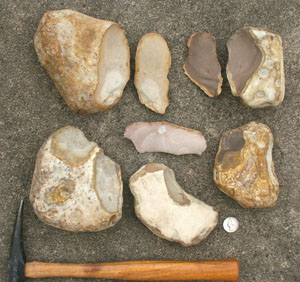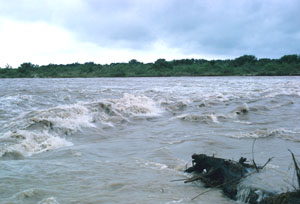Nueces River Gravels
The gravel bars of the Nueces River, the largest river that winds across the center of the South Texas Plains, and its major tributary, the Frio River, were prime sources of tool-making rocks. These gravels are a bit hard to characterize because they include chert cobbles washed down from the Edwards Plateau as well as reworked gravels from the Uvalde gravels as well. In addition to active gravel bar exposures directly along and within the river, there are also gravel exposures in the older river terraces in many places along the Nueces and Frio Rivers.
Here, let’s divide the Nueces River in the South Texas Plains has having three segments: the upper Nueces, from the Balcones Escarpment south to where the river starts to swing eastward, just upstream from Cotulla; the middle Nueces, from Cotulla to just below below Three Rivers where the river swings back more to the south; and the lower Nueces, from Three Rivers to where the river enters the Corpus Christi Bay system.
In general, the larger and better-quality cobbles are easier to find in the upper Nueces closer to the Edwards Plateau. There one can find sizeable tabular cobbles (some over 30 centimeters or 12 inches across) that are ideal for flintknapping. Cobble size is more or less progressively smaller and rounder as one travels downstream. Decent-sized materials (cobbles 15-25 centimeters or 6-10 inches across) can still be found in the middle Nueces and lower Frio gravels.
In the lower Nueces, particularly the last 20-30 miles through the flat coastal plains, most pieces are pebble-sized and too small for stone-tool making. The closests sources to the coast are gravel exposures some 30-35 kilometers (roughly 20 miles) upstream from the mouth of the river. There chert cobbles are quite small (at most 15 centimeters or 6 inches across), but still serviceable for flake tools and arrow points. No gravels are found as one nears the mouth of the Nueces, although there are probably gravels buried deeply beneath fine sediments. These posited buried gravels may well have been exposed during Late Pleistocene times, when the sea level was considerably lower and the bay systems had yet to fully form.
Although chert is the most important and common material among the Nueces gravels, there are pieces of quartzite, limestone (in the upper Nueces), sandstone, and other materials in some stretches in the middle and lower Nueces. Like virtually all sources of chert in the South Texas Plains, much of the material found in Nueces gravels is relatively coarse-grained and cobbles are relatively small. Nonetheless, the prehistoric hunter-gathering peoples along the upper and middle Nueces always had dependable sources of tool-making materials.

Nueces River gravels collected near the Anthon site in southern Uvalde County. Here relatively large, good quality cherts are common. Courtesy Glenn T. Goode. |
|
High quality chert cobble collected in Nueces River gravels near the Anthon site in southern Uvalde County. This tabular material is clearly derived from the limestone formations of Edwards Plateau, which are encountered less than 20 miles upstream. Courtesy Glenn T. Goode. |

High-energy flood on the Nueces River near the Anthon site in southern Uvalde County. This is the mechanism by which gravels move down river. TARL Archives. |

